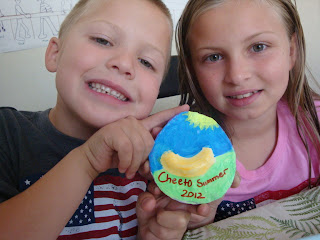How many bags of Cheetos would it take to keep a Honda Fit afloat?
A Honda Fit has a curb weight of 2423 lbs. What would be your guess? In the group of people we asked there was a low of 500 bags, and a high of 500,000, an average of 53,800, and a median of 10000 bags.
The Experiment
To do this experiment we used a cooler, a large bag of Cheetos Puffs, two hangers, and a measuring cup.
1. We filled the cooler about half full with water.
2. We put the unopened bag of Cheetos into the cooler.
3. We used the hangers to completely push the bag of Cheetos underwater.
2. We put the unopened bag of Cheetos into the cooler.
3. We used the hangers to completely push the bag of Cheetos underwater.
4. We marked the water level.
5. We removed the Cheetos from the water.
6. We measured how much water it took to fill the cooler to the mark.
5. We removed the Cheetos from the water.
6. We measured how much water it took to fill the cooler to the mark.
Results
Archimedes' principle states that the upward buoyant force will be equal to the weight of the displaced water. Google helped us find the weight of a gallon of water, 8.345 lbs. It took 26 cups of water (1.625 gallons) to fill the cooler to the bandaid. 8.345 * 1.625 = 13.561 lbs. Each bag of Cheetos weighs 9.75 ounces or 0.609 lbs. To find out how much buoyancy lift each bag of Cheetos provides we will take the total displacement weight of the bag of Cheetos minus the weight of the bag.
13.561 - .609 = 12.952 lbs total buoyancy.
To find the total number of bags required we will take the total weight of the car, 2423 lbs, and divide the total buoyancy of one bag of Cheetos, 12.952 lbs.
2423 / 12.952 = 187.075 bags of Cheetos. Since we don't have fractional bags of Cheetos we will round up to 188 bags. 188 bags of Cheetos will float a Honda fit.
How many bags would it take to keep your car afloat? Google "curb weight" and the name of your car. Divide the curb weight by 12.952 to figure it out.
This is a simple experiment and was entertaining for everyone involved. It was easy have lots of parts for everyone to perform, and it helped to get every one's predictions first.
Now, do you think it will be possible to get Frito Lay to donate 188 bags of Cheetos so we can test our theory? Maybe Mythbusters would take on the experiment to build an actual raft with Cheetos.
.JPG)
.JPG)


























